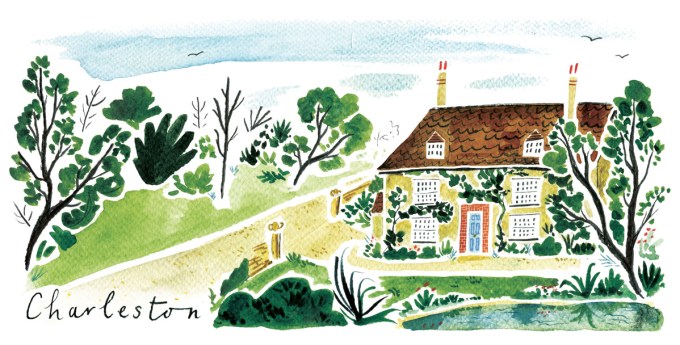A Loving Illustrated Homage to Virginia Woolf’s Remarkable Life and Legacy
By Maria Popova
“Behind the cotton wool is hidden a pattern,” Virginia Woolf wrote in recounting the sublime epiphany in which she knew she was an artist. “The whole world is a work of art… There is no Shakespeare, there is no Beethoven; certainly and emphatically there is no God; we are the words; we are the music; we are the thing itself.”
In Virginia Woolf: An Illustrated Biography (public library) — a fine addition to these favorite illustrated biographies of luminaries and one of four wonderful picture-books about the creative life I recently reviewed for The New York Times — writer Zena Alkayat and artist Nina Cosford pull back the cotton wool of Woolf’s own remarkable life and explore the thing itself with equal parts concision, compassion, and unsentimental reverence.
From her childhood, marked by literature and loss from an early age — the two great constants of her life — to her emergence as one of the most singular and significant artistic voices of the past century, the story follows Woolf’s creative development and unearths the building blocks of her formidable legacy.
While her brothers were away at school, Virginia would read and write obsessively. Her older sister Vanessa spent hours at her easel.
They went on to devote their lives to each other.
Woven into the story are unforgettably electrifying lines from Woolf’s books, journals, and letters. Woolf writes in her diary in October of 1933:
I will not be ‘famous,’ ‘great.’ I will go on adventuring, changing, opening my mind and my eyes, refusing to be stamped and stereotyped.
We meet Woolf’s sister, the artist Vanessa Bell, and their Bloomsbury posse of artists and intellectuals; Woolf’s husband, Leonard, and their pet marmoset Mitz, a mascot of the Bloomsbury group; her beloved nephews, Quentin and Julian, with whom she collaborated on a humorous family newspaper; her lover Vita Sackville-West, the inspiration for Woolf’s gender-bending, genre-bending, groundbreaking novel Orlando, which Sackville-West’s son rightly called “the longest and most charming love letter in literature.”
Leonard had spent seven years working for the Colonial Civil Service in Ceylon. He was a writer, an intellectual, and a perfectionist.
He was also tall and dark with blue eyes and trembling hands.
[…]
Leonard would call her “mandrill.” Virginia would call him “mongoose.”
While enjoying London’s party scene, Virginia met the aristocratic Vita Sackville-West.
Vita’s life was scandalous. She had an open marriage, passionate lesbian affairs, and a penchant for cross-dressing. She was also a mother, a writer, and a poet.
As their relationship bubbled and fizzled, Virginia wrote To the Lighthouse. It was an ode to her parents.
There is struggle — it takes fifteen years for Woolf’s debut novel to sell 2,000 copies, and in those years she survives a World War and a severe bout of depression that nearly takes her life. There is also joy — the seemingly idyllic Charleston retreat of the Bloomsbury set, and the simple joys of dogs and gardening and the ocean.
Every great biography, in telling the story of a particular personhood, recreates the texture of the era in which that personhood unfolded. Intersecting the line of Woolf’s life are cultural milestones, events both triumphant and tragic.
The suffrage movement paves the way for women’s intellectual, creative, and sexual emancipation as young Virginia is finding that room of her own.
When the war comes, we see Virginia and Leonard crouching in their coal cellar, where they take shelter night after nightmarish night.
On March 28, 1941, Virginia fills her overcoat pockets with rocks, leaves Leonard a poignant farewell letter, walks into the River Ouse behind their house, and drowns. Measured by its end, her life is undeniably tragic. Measured by its substance, a sort of creative aliveness which few artists have matched in the entire history of humanity, it is undeniably triumphant. The book is a reminder — perhaps uncomfortable, but very much necessary and ultimately jubilant — that complexity and contradiction are the raw material of life, and that an extraordinary life contains an extraordinary dosage of both.
Complement Alkayat and Cosford’s marvelous Virginia Woolf, which is part of their series of illustrated biographies of exceptional women, with notable picture-books celebrating Louise Bourgeois, e.e. cummings, Pablo Neruda, Jane Goodall, Albert Einstein, and Nellie Bly, then revisit Woolf on how to read a book, why the best mind is the androgynous mind, the paradox of the soul, and the creative benefits of keeping a diary.
Illustrations © Nina Cosford courtesy of Chronicle Books; photographs by Maria Popova
—
Published April 12, 2016
—
https://www.themarginalian.org/2016/04/12/virginia-woolf-alkayat-cosford/
—


























ABOUT
CONTACT
SUPPORT
SUBSCRIBE
Newsletter
RSS
CONNECT
Facebook
Twitter
Instagram
Tumblr